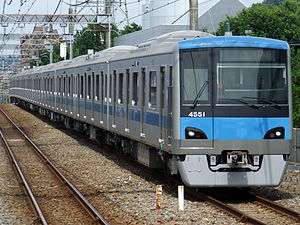Odakyū Tama Line
This article needs additional citations for verification. (November 2015) |
| Odakyu Tama Line | ||
|---|---|---|
 An Odakyu 4000 series EMU on the Tama Line in July 2007 | ||
| Overview | ||
| Native name | 小田急多摩線 | |
| Owner | Odakyu Electric Railway | |
| Locale | Kanto region | |
| Termini | Shin-Yurigaoka Karakida | |
| Stations | 8 | |
| Service | ||
| Type | Commuter rail | |
| History | ||
| Opened | 1 June 1974 | |
| Technical | ||
| Line length | 10.6 km | |
| Track gauge | 1,067 mm (3 ft 6 in) | |
| Electrification | 1,500 V DC overhead catenary | |
| ||
The Odakyu Tama Line (小田急多摩線, Odakyū Tama-sen) is a railway line operated by the private railway operator Odakyu Electric Railway in the Greater Tokyo of Japan. The line extends 10.6 kilometres (6.6 mi) from Shin-Yurigaoka Station in Kanagawa Prefecture to Karakida Station in Tokyo.
Used for commuter service by the residents of Tama New Town, the largest New Town in Japan, rapid trains are frequent on the line, through to Odakyu's Tokyo terminus at Shinjuku on the Odakyu Odawara Line) or via the Tokyo Metro Chiyoda Line subway with connections onward to the Joban Line. Tama Express trains terminate at Toride Station in Toride, Ibaraki, on the opposite side of Tokyo.[1]
Service patterns[]
- Express (急行, Kyūkō)
- Up to Shinjuku or Ayase on the Tokyo Metro Chiyoda Line. One exception is down from Shin-Yurigaoka. Weekday mornings only.
- Local (各駅停車, Kakueki Teisha)
- Mostly in the line only, and some from/to Shinjuku, all day long.
Former Service[]
- Tama Express (多摩急行, Tama Kyūkō)
- All from/to Toride on East Japan Railway Company (JR East) Joban Line via the Chiyoda Line. All day.
Stations[]
- Local and Section Semi Express services stop at all stations.[1]
| No. | Station | Japanese | Distance (km) | Tama Express |
Express | Transfers | Location | ||
|---|---|---|---|---|---|---|---|---|---|
| Between stations |
Total | ||||||||
| From Shin- Yurigaoka |
From Shinjuku | ||||||||
| Through operation to: | Shinjuku Station (Odakyu Odawara Line) Toride Station (Joban Line) via the Tokyo Metro Chiyoda Line | ||||||||
| Shin-Yurigaoka | 新百合ヶ丘 | - | 0.0 | 21.5 | ● | ● | Odakyu Odawara Line (for Shinjuku, Odawara) | Asao-ku, Kawasaki, Kanagawa Prefecture | |
| Satsukidai | 五月台 | 1.5 | 1.5 | 23.0 | | | | | |||
| Kurihira | 栗平 | 1.3 | 2.8 | 24.3 | ● | ● | |||
| Kurokawa | 黒川 | 1.3 | 4.1 | 25.6 | | | | | |||
| Haruhino | はるひ野 | 0.8 | 4.9 | 26.4 | | | | | |||
| Odakyū-Nagayama | 小田急永山 | 1.9 | 6.8 | 28.3 | ● | ● | Keio Sagamihara Line (Keiō-Nagayama) | Tama, Tokyo | |
| Odakyū-Tama-Center | 小田急多摩センター | 2.3 | 9.1 | 30.6 | ● | ● | Keio Sagamihara Line (Keiō-Tama-Center) Tama Toshi Monorail Line (Tama-Center) | ||
| Karakida | 唐木田 | 1.5 | 10.6 | 32.1 | ● | ● | |||
History[]
This section does not cite any sources. (May 2017) |
This line was built as a part of Tokyo Line 9, linked with the Tokyo Metro Chiyoda Line and Odakyu Odawara Line.
Odakyu started service on the first section, from Shin-Yurigaoka to Odakyū-Nagayama, on June 1, 1974. It expanded to Tama Center, the central station of Tama New Town, on April 23, 1975. This section was constructed by the national Japan Railway Construction Corporation, since renamed the Japan Railway Construction, Transport and Technology Agency (JRTT), while Odakyu operated it and paid for the organization. On March 27, 1990, Odakyu opened Karakida station.
The line was constructed as double track, but Odakyu could not take a large part of the transport between Tokyo and Tama New Town. Delay to the quadrupling of the main Odawara Line due to long standing land acquisition conflicts prevented operating extra trains that were to connect the new town and the terminus of Shinjuku.
Rapid train services on the Tama Line began in 2000, and succeeded in increasing the number of passengers, shorting transit time.
References[]
This article incorporates material from the corresponding article in the Japanese Wikipedia.
- ^ Jump up to: a b 首都圏鉄道完全ガイド 主要私鉄編 [Tokyo Area Complete Railway Guide - Major Private Lines] (in Japanese). Japan: Futabasha. 22 July 2013. p. 12. ISBN 978-4-575-45387-4.
- Lines of Odakyu Electric Railway
- Railway lines in Kanagawa Prefecture
- Railway lines in Tokyo
- 1067 mm gauge railways in Japan
- Railway lines opened in 1974
- 1974 establishments in Japan